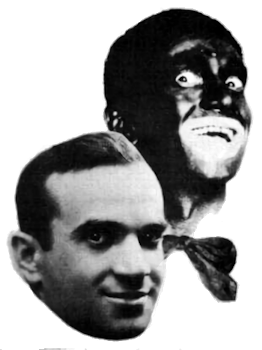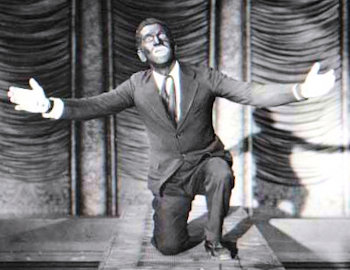
|
Al Jolson
Blackface and Racism |
 |

|
Al Jolson
Blackface and Racism |
 |
But those are just not the facts of history, nor the man named Al Jolson. In this section, there are a variety of articles and features to help understand that the blackface make-up that Al Jolson wore was make-up for a character, just as every entertainer wears make-up on stage or screen. That style of make-up, now understood to be offensive, was one of the conventions of theater 100 years ago, and must be viewed in that light, through the eyes of the day. Al Jolson is often the example of blackface, because he was just that famous. He was not, however, the only performer wearing it, nor even part of a minority wearing it. He was just the one who is remembered today. The following pieces will attempt to put blackface in context, and help view Al Jolson's view on difference in race, and his actions in that behalf.
| New York Times on Jolson and Blackface | On October 22, 2000, fifty years after the passing of Al Jolson, the New York Times published this insightful article, Al Jolson: A Megastar Long Buried Under a Layer of Blackface. Author Ted Gioia dives into the issue, and presents a clearer picture of Al Jolson, under that layer of burnt cork. |
| Los Angeles Times on Jolson and Blackface | On October 20, 2000, responding to Spike Lee's film, "Bamboozled," Robert Moss wrote this detailed article about the real history of Al Jolson and blackface, reviewing the revisionist biases held against Jolson, in his article "Was Al Jolson 'Bamboozled'?" |
| PBS B'WAY - Broadway The American Musical | The 2004 PBS special on the history of Broadway says of Al Jolson, "Al Jolson paved the way for African-American performers like Louis Armstrong, Duke Ellington, Fats Waller, and Ethel Waters. It is remarkable that a Jewish mamma's boy from Lithuania could do so much to bridge the cultural gap between black and white America." Here is a look at a page devoted to that program. The material from the series is available on the Bibliography Page on this website. |
| Los Angeles Times on History of Blackface | On July 31, 1977, Don Carle Gillette took a sweeping look at the history of blackface, which included interviews with Bert Williams, Eddie Cantor, and Al Jolson. His article gives a perspective of blackface from the time it was being used, including sensitivity that is often overlooked today. Read his article, "Burnt Cork as the Sincerest Form of Flattery." |
| Jolson and African Americans | Professor Charles Musser, a professor of Film Studies at Yale University, published an excellent and detailed paper in 2011 entitled, "Why Did Negroes Love Al Jolson and The Jazz Singer?: Meledrama, Blackface and Comsopolitan Theatrical Culture," which takes an in-depth look at Jolson, blackface, and the question of racism. Prof. Musser has given permission for his paper to be placed on this page, and I encourage your reading it in full. |
| Noble Sissle, Eubie Blake & Al Jolson | Noble Sissle and Eubie Blake were songwriting partners since 1915, bringing Shuffle Along, the first show to make African-American dance an integral part of American musical theatre, to Broadway in 1921. When they were denied service at a restaurant due to their race two years before, Al Jolson stepped in. Read their story on this page of the site. |
| Noble Sissle on Al Jolson and racism | In the Spring of 1938, there was a dispute about a zoning issue in Encino, where Al Jolson was the mayor, which was said to restrict African Americans from living in the area. This was subsequently shown to be an effort by a resident of the area, not Jolson, and Jolson had nothing to do with it. Noble Sissle, famed African American songwriter, came to his defense, as stated in this April 22, 1938, article. |
| Prof. Joe Ciolino letter | In the early 2000s, efforts to have Al Jolson recognized on Broadway had stalled. At that time, Professor Joe Ciolino wrote a letter in support of the planned action. That letter included an in-depth look at some of the misconceptions held about Al Jolson, and can be read by clicking the link. With the support mustered, Al Jolson Way became a reality at the corner of Broadway and 51st Street, in front of the Winter Garden Theater, that Al Jolson had opened. |
| Misunderstood Hero or Villain | Here is a fascinating video by Simon Whistler, part of his Today I Found Out YouTube channel, entitled Al Jolson - Misunderstood Hero or Villain. He also elaborates on Jolson's race relationships and history, with more facts about the man. |
| Young Person Reaction | A young man, Ty Smith, has a YouTube channel called Modern Renaissance Man where he looks, and comments about, a wide variety of entertainment forms. It was suggested that he listen to Al Jolson, and here is that video, his first exposure to Al Jolson, singing "Swanee." |
| Dolores Kontowicz | Here is a letter to the editor, from March 30, 1992, written by Dolores Kontowicz in response to an article suggesting that Jolson was racist. Dolores was the founder of the International Al Jolson Society, the president for years, and remained dear to us until her passing in 2010. |
| Thomas Connolly | Another newpaper article penned by IAJS leadership was published in 1999, written by the late Thomas Connolly. His piece, "Jolson wasn't racist, even in blackface," was triggered by a reaction to the play "Jolson - The Musical," and reviews a wide range of incidents involving Jolson and African Americans. |
| They Also Blacked Up | Whenever blackface makes the news, a picture of Al Jolson is often brought out to illustrate the make-up and comment on it's perception and implied racism. But Jolson was not the first nor the only person to black up, just the most famous. Here is a look at other people of the stage and screen who also wore blackface -- for theater, not as racists. |
| Al Jolson on racism |
This is an excerpt of the 06 Jun 1945 Milton Berle Show, featuring Al Jolson with biographical musical vignettes of his life, and illustrated with images of the stars, real and composite, to get a feeling for the broadcast. . Having just recovered from the loss of much of a lung, Jolson's appearance between V-E Day and V-J Day was a poignant look at the World's Greatest Entertainer in a fragile time of his life. Listen to his words about racial and ethnic tolerance, so moving from a man often painted as a racist. |
Al Jolson wore blackface, he was not a racist. Neither were Bing Crosby, Fred Astaire, Judy Garland, or multitudes of others who blacked up for a role. Racism is defined in one's actions and one's motivations, not necessarily by the color of one's make-up, or of one's skin.
|
Updated 20 Feb 24 |